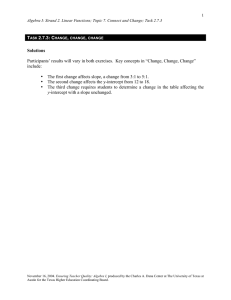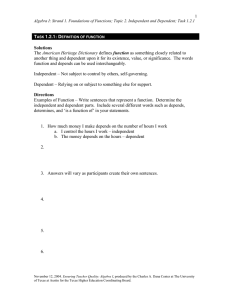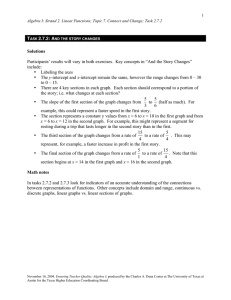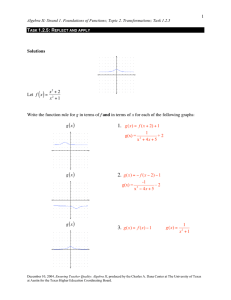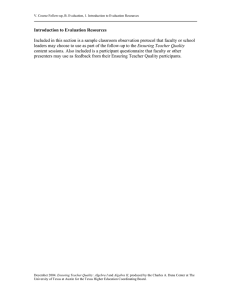1 1. The following is one example of connecting the... expression
advertisement
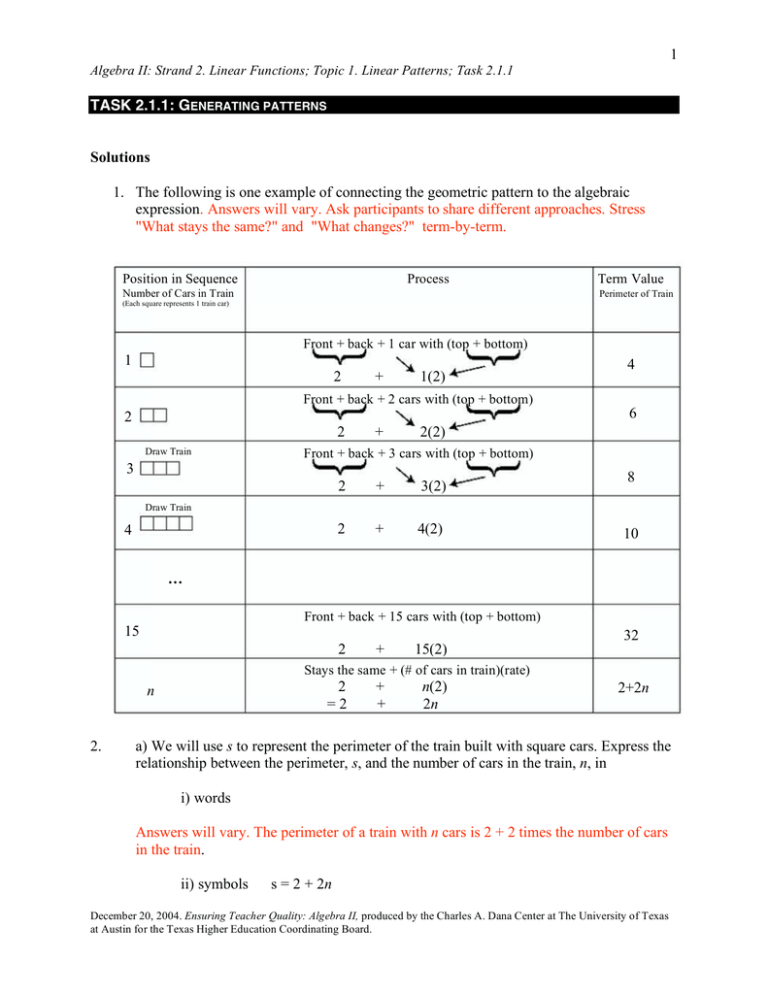
1 Algebra II: Strand 2. Linear Functions; Topic 1. Linear Patterns; Task 2.1.1 TASK 2.1.1: GENERATING PATTERNS Solutions 1. The following is one example of connecting the geometric pattern to the algebraic expression. Answers will vary. Ask participants to share different approaches. Stress "What stays the same?" and "What changes?" term-by-term. Position in Sequence Process Number of Cars in Train Term Value Perimeter of Train (Each square represents 1 train car) Front + back + 1 car with (top + bottom) 1 2 + 1(2) Front + back + 2 cars with (top + bottom) 2 2 Draw Train 3 + 4 6 2(2) Front + back + 3 cars with (top + bottom) 2 + 3(2) 2 + 4(2) 8 Draw Train 4 10 … Front + back + 15 cars with (top + bottom) 15 2 + 15(2) 32 Stays the same + (# of cars in train)(rate) 2 =2 n 2. + + n(2) 2n 2+2n a) We will use s to represent the perimeter of the train built with square cars. Express the relationship between the perimeter, s, and the number of cars in the train, n, in i) words Answers will vary. The perimeter of a train with n cars is 2 + 2 times the number of cars in the train. ii) symbols s = 2 + 2n December 20, 2004. Ensuring Teacher Quality: Algebra II, produced by the Charles A. Dana Center at The University of Texas at Austin for the Texas Higher Education Coordinating Board. 2 Algebra II: Strand 2. Linear Functions; Topic 1. Linear Patterns; Task 2.1.1 b) Which quantity depends on the other quantity? The perimeter of the train depends on the number of cars in the train. In other words, the number of cars in the train determines the perimeter. c) State this dependency relationship between the perimeter and the number of cars in the train using the phrase "is a function of." Answers will vary. The perimeter of a train formed by square-shaped cars is a function of the number of square-shaped cars in the train. d) Translate the relationship you stated in part (c) into function notation. s(n) = 2 + 2n 3. Using your graphing calculator, make a scatterplot of the data, and graph the function s over the scatterplot. The context of this problem limits the domain and range to discrete data. However, we use the linear function to predict the perimeter of a train with a given number of cars or to predict the number of cars when given the perimeter. At this point, ask the participants to make the scatterplot and sketch the graph of s by hand. Compare the sketches to the graphs produced by the calculator to help participants connect the different representations. 4. 5. 6. What does the ordered pair (15,32) on your function graph mean? It means that a train with 15 square cars has a perimeter of 32 units. What is the perimeter of the train with 64 cars? How do you know? The perimeter of a train with 64 cars is 130 units. Answers will vary; participants may use the graph or table to locate the point at which x has a value of 64. They may also have used the expression for perimeter and substituted 64 for n as follows. s(n) = 2 + 2n s(64) = 2 + 2(64) s(64) = 2 + 128 s(64) = 130 If the perimeter of a train is 64, how many square pattern blocks would you need to build the train? Explain at least two ways of getting an answer. Answers will vary. The following are examples of how participants may respond. December 20, 2004. Ensuring Teacher Quality: Algebra II, produced by the Charles A. Dana Center at The University of Texas at Austin for the Texas Higher Education Coordinating Board. 3 Algebra II: Strand 2. Linear Functions; Topic 1. Linear Patterns; Task 2.1.1 Using the table feature of the graphing calculator, scroll down the x-values until you locate the value of 64 for Y1= 2 + 2x. A second method is to use the trace feature of the graphing calculator. In an integer window, graph Y1= 2 + 2x and trace along the function until you locate a y-value of 64. Another method is to substitute 64 for the value of s(n) and solve algebraically. s(n) = 2 + 2n 64 = 2 + 2n 62 = 2n 31 = n Additional questions Ask participants to describe each ordered pair. In other words, what does the number 31 and the number 64 mean? A train with 31 square cars has a perimeter of 64 units. What does the x-axis represent on our graph? The number of cars in each train we build. What does the y-axis represent on our graph? The perimeter of each train we build. Does the model s(n) = 2x + 2 accurately represent the train situation? Why or why not? December 20, 2004. Ensuring Teacher Quality: Algebra II, produced by the Charles A. Dana Center at The University of Texas at Austin for the Texas Higher Education Coordinating Board. 4 Algebra II: Strand 2. Linear Functions; Topic 1. Linear Patterns; Task 2.1.1 According to the model, a train with no cars still has a perimeter of 2; however, no such train exists. Also, the model is a continuous function, while the train situation is a discrete function. Do all of the x-values on the line have meaning in the problem situation? No, there are no trains with a fractional number of cars. Also, there are no negative trains. This tells us that the domain of our train situation is the counting numbers. Do all of the y-values on the line have meaning in the problem situation? No, our trains in this case will only have even perimeters, and the first train has a perimeter of 4. This tells us that the range of our train situation is all the even numbers greater than or equal to 4. Remember that we initially defined a function as a relationship between two quantities such that one quantity is associated with a unique value of the other quantity. What are the advantages of using functions (instead of non-functions) to describe relationships between quantities? Answers will vary. Since a function is a relationship that associates a value of the independent variable with a unique value of a dependent variable, we can use the function model for prediction. In our train example, we can use our function model to predict the perimeter of a train with any number of cars without having to build the train. This illustrates an important aspect of the train situation; we could have any number of cars in our train, so the creation of a symbolic representation for the model allows us to easily investigate very long trains. 7. If the perimeter of a train is 27, how many square pattern blocks would you need to build the train? Explain. If we can use only whole squares, we cannot build a train with a perimeter of 27. It would require 12.5 square pattern blocks. Explanations and justifications will vary. 8. Repeat the process in step 1 using the equilateral triangle to form the train. What is your unit of measurement? Can you still use the side of the square as your unit? Why? Yes. A side of the triangle is the same length as a side of the square. The following is one example of connecting the geometric pattern to the algebraic expression. Answers will vary. Ask participants to share different approaches. Stress "What stays the same?" and “What changes?" and "rate of change" term-by-term. December 20, 2004. Ensuring Teacher Quality: Algebra II, produced by the Charles A. Dana Center at The University of Texas at Austin for the Texas Higher Education Coordinating Board. 5 Algebra II: Strand 2. Linear Functions; Topic 1. Linear Patterns; Task 2.1.1 Position in Sequence Term Value Process Number of cars in train Perimeter of Train 1 Front + back + 1 horizontal 2 + 1 3 2 Front + back + 2 horizontal 2 + 2 4 Front + back + 3 horizontal 2 + 3 5 Draw Train 3 Draw Train 4 Stays the same + (what changes) 2 + (4) 6 ... 15 2 n 9. + (15) 2+n 17 2+n Rewrite the pattern above as a function t. Write both the verbal and mathematical representation of the function. t(n) = 2 + n The perimeter of a train formed by triangular-shaped cars is a function of the number of triangular-shaped cars in the train. 10. Using your graphing calculator, make a scatterplot of the data. Graph the function t over the scatterplot. December 20, 2004. Ensuring Teacher Quality: Algebra II, produced by the Charles A. Dana Center at The University of Texas at Austin for the Texas Higher Education Coordinating Board. 6 Algebra II: Strand 2. Linear Functions; Topic 1. Linear Patterns; Task 2.1.1 11. What is the perimeter of a train built with 18 triangle-shaped blocks? Explain at least two ways of getting an answer. Answers will vary. The following are examples of how participants may respond. Reset your window to include the value of 18 in the x-range. Graph the function and press the trace key. Type 18, the x-value, and press enter. The perimeter of a train with 18 cars is 20. (18,20) Another method is to evaluate the function when n = 18. On the home screen locate the function Y1(Press VARS, select Y_VARS, select Function, select your function), type (18)and press enter). The result is shown to the right. December 20, 2004. Ensuring Teacher Quality: Algebra II, produced by the Charles A. Dana Center at The University of Texas at Austin for the Texas Higher Education Coordinating Board. 7 Algebra II: Strand 2. Linear Functions; Topic 1. Linear Patterns; Task 2.1.1 12. Repeat the process one more time, this time using the trapezoid pattern block. What is your unit of measurement? The following is one example of connecting the geometric pattern to the algebraic expression. Answers will vary. Ask participants to share different approaches. Stress "What stays the same?" and "What changes?" and "rate of change" term-by-term. The side of the square is still the unit. The longer base of the trapezoid is two units long. Position in Sequence Value Process Term Number of Cars in Train Perimeter of Train (Front + back) + (bottom with length 2 + top with length 1) · 1 car 1 2 + 3 5 (1) (Front + back) + (3 bottom and top segments) · 2 cars 2 2 + 3(2) 8 Draw Train 3 2 + 3(3) 11 2 + 3(4) 14 2 + 3(15) 47 Draw Train 4 … 15 (Front + back) + (3 bottom and top segments) · n cars n 13. 2 + 3n 2+3n Rewrite the pattern above as a function z. Write both the verbal and mathematical representation of the function. z(n) = 2 + 3n The perimeter of a train formed by trapezoid-shaped cars is a function of the number of trapezoid-shaped cars in the train. December 20, 2004. Ensuring Teacher Quality: Algebra II, produced by the Charles A. Dana Center at The University of Texas at Austin for the Texas Higher Education Coordinating Board. 8 Algebra II: Strand 2. Linear Functions; Topic 1. Linear Patterns; Task 2.1.1 14. Using your graphing calculator, make a scatterplot of the data. Graph the function z over the scatterplot. 15. If the perimeter of a train is 35, how many trapezoid pattern blocks would you need to build the train? Explain at least two ways of getting an answer. You will need 11 trapezoid pattern blocks. Methods will vary. Ask participants to explain. 16. This really is the last one. Using the hexagon, please repeat the process of building each train, determining the perimeter, and describing your thinking, as you did with the square, triangle, and trapezoid. The following is one example of connecting the geometric pattern to the algebraic expression. Answers will vary. Ask participants to share different approaches. Stress "What stays the same?" and "What changes?" and "rate of change" term-by-term. December 20, 2004. Ensuring Teacher Quality: Algebra II, produced by the Charles A. Dana Center at The University of Texas at Austin for the Texas Higher Education Coordinating Board. 9 Algebra II: Strand 2. Linear Functions; Topic 1. Linear Patterns; Task 2.1.1 Position in sequence Term Value Process (Front + back) + (2 top + 2 bottom) · 1 car 1 2 + 4 (1) (Front + back) + (2 top + 2 bottom) · 2 cars 2 Draw Train 2 + 4 (2) (Front + back) + (2 top + 2 bottom) · 3 cars Draw Train 2 + 4 (3) (Front + back) + (2 top + 2 bottom) · 4 cars 3 4 2 … + 4 6 10 14 18 (4) Stays the same + rate of change (what changes) (Front + back) + (2 top + 2 bottom) · 15 cars 15 n 17. 2 + 2+4n 4 (15) 62 2+4n Rewrite the pattern above as a function h. Write both the verbal and mathematical representation of the function. h(n) = 2 + 4n The perimeter of a train formed by hexagonal-shaped cars is a function of the number of hexagonal-shaped cars in the train. 18. Using your graphing calculator, make a scatterplot of the data. Graph the function h over the scatterplot. December 20, 2004. Ensuring Teacher Quality: Algebra II, produced by the Charles A. Dana Center at The University of Texas at Austin for the Texas Higher Education Coordinating Board. 10 Algebra II: Strand 2. Linear Functions; Topic 1. Linear Patterns; Task 2.1.1 19. How many hexagonal-shaped cars would you need to build a train with a perimeter of 82? Explain at least two ways of getting an answer. You will need 20 cars. Methods will vary. Ask participants to explain. 20. Graph each function (s, t, z, and h) on the graph below. Label each function. What happens to the graphs as the number of sides in a train car grows? As the perimeter of a one-car train increases, the rate of change for the train perimeter function becomes greater and the graphs become steeper. 21. What point do all the graphs have in common? (0,2) Where does this show up in each equation? It is the constant term. What is this point called? The y-intercept. What does this point represent? This point represents the quantity that stayed the same in each term of each pattern. In this context (trains), a zero-car train still maintains a constant perimeter, 2. Additional questions Based on the functions and their graphs, predict what the function and graph would look like for a train built with octagonal blocks. Confirm your predictions. December 20, 2004. Ensuring Teacher Quality: Algebra II, produced by the Charles A. Dana Center at The University of Texas at Austin for the Texas Higher Education Coordinating Board. 11 Algebra II: Strand 2. Linear Functions; Topic 1. Linear Patterns; Task 2.1.1 g(n) = 2 + 6n Every time I add a car to a train, by how many units does the perimeter increase? Squares by two units per car. Triangles by one unit per car. Trapezoids by three units per car. Hexagons by four units per car. Math notes This task presents a series of concrete exercises for building linear patterns. The mathematical focus in this task centers around the idea that constant finite differences (over intervals of equal length) are characteristic of linear functions. The mathematical modeling involved in determining the patterns also highlights the diverse perspectives in modeling that give rise to equivalent linear models. Teaching notes This task, originally written for teachers of grades 5-8, gives participants a powerful insight into the modeling, manipulatives, and experiences to which students in grades 5-8 have been exposed. It is important to have participants revisit their models and try to think of other ways that they could have modeled the linear patterns. This will be seen in their process column. Facilitators can do this by having students with different models present their model and have the rest of the participants try to relate the expressions presented to the features of the concrete models. For example, one way of finding the function s(n) = 2 + 2n is that which is modeled in the solution to Question (1) above—process column indicates that the model used is that the perimeter units from front and the back of the train are constant throughout and that each additional train only adds two units to the perimeter of the train. However, participants may model the train by using the initial perimeter of 4 as the quantity that remains constant throughout and each additional train adds two units to the perimeter of the train. Thus, their process column would indicate 4 + 2(n ! 1) . December 20, 2004. Ensuring Teacher Quality: Algebra II, produced by the Charles A. Dana Center at The University of Texas at Austin for the Texas Higher Education Coordinating Board. 12 Algebra II: Strand 2. Linear Functions; Topic 1. Linear Patterns; Task 2.1.1 !Initial perimeter 4 units !Initial perimeter 4 units plus 2 units contributed by 2 nd train !Initial perimeter 4 units plus 2 units contributed by 2 nd train and 2 more units from the 3 rd train OR initial perimeter 4 units (n= 1) plus two units per additional train (2*(n -1)) Require that the participants use the pattern blocks to explain their models and the models of others. See the additional questions that can be asked that appear in the solutions above after Questions 6 and 21. In this task, participants will have explored five ways to represent functions: concretely (with manipulative), verbally (in words), numerically (by tables), graphically (by graphs), and symbolically (by formulas). Have a class discussion about the importance of having students construct these different representations and making connections among them at the appropriate time in their development. Also discuss the importance of connecting multiple representations of functions as a foundational requirement for student success in advanced coursework. Technology notes Visit http://www.esc4 .net/ math for Texas Instrument graphing calculator instructions and http://www.esc4 .net/math/casio for directions in using Casio graphing calculators. December 20, 2004. Ensuring Teacher Quality: Algebra II, produced by the Charles A. Dana Center at The University of Texas at Austin for the Texas Higher Education Coordinating Board. 13 Algebra II: Strand 2. Linear Functions; Topic 1. Linear Patterns; Task 2.1.1 TASK 2.1.1: GENERATING PATTERNS 1. Use square pattern blocks to build each term in the sequence. Position blocks such that the model simulates a train with one complete edge of each car touching as shown in position 1 and 2. Determine the perimeter of the figure. Describe your thinking process as you relate the number of cars in the train to the perimeter of the train. Using your line of thinking, predict the perimeter of the train with 15 cars. Position in Sequence Number of cars in train (each square represents one train car) 1 Process Term Value Perimeter of train 4 2 Draw train 3 Draw train 4 … 15 n 2. a) We will use S to represent the perimeter of the train built with square cars. Express the relationship between the perimeter, S, and the number of cars in the train, n in i) words ii) symbols December 20, 2004. Ensuring Teacher Quality: Algebra II, produced by the Charles A. Dana Center at The University of Texas at Austin for the Texas Higher Education Coordinating Board. 14 Algebra II: Strand 2. Linear Functions; Topic 1. Linear Patterns; Task 2.1.1 Find as many ways as possible to relate the geometric pattern to your symbolic expression. b) Which quantity depends on the other quantity? c) State this dependency relationship between the perimeter of a train and the number of cars in the train using the phrase “is a function of.” d) Translate the relationship you stated in part (c) into function notation. s(n) = 3. Using your graphing calculator, make a scatterplot of the data, and graph the function S over the scatterplot. 4. What does the ordered pair (15, 32) on you function graph mean? 5. What is the perimeter of the train with 64 cars? How do you know? December 20, 2004. Ensuring Teacher Quality: Algebra II, produced by the Charles A. Dana Center at The University of Texas at Austin for the Texas Higher Education Coordinating Board. 15 Algebra II: Strand 2. Linear Functions; Topic 1. Linear Patterns; Task 2.1.1 6. If the perimeter of a train is 64, how many square pattern blocks would you need to build the train? Explain at least two ways of getting an answer. 7. If the perimeter of a train is 27, how many square pattern blocks would you need to build the train? Explain. 8. Repeat the process in step 1 using the equilateral triangle to form the train. What is your unit of measurement? Can you still use the side of the square as your unit? Why? Position in Sequence Number of… cars in train (each triangle represents one train car) Process Term Value Perimeter of train 4 1 2 Draw train 3 Draw train 4 15 n 9. Rewrite the pattern above as a function of t. Write both the verbal and mathematical representation of the function. December 20, 2004. Ensuring Teacher Quality: Algebra II, produced by the Charles A. Dana Center at The University of Texas at Austin for the Texas Higher Education Coordinating Board. 16 Algebra II: Strand 2. Linear Functions; Topic 1. Linear Patterns; Task 2.1.1 10. Using your graphing calculator, make a scatterplot of the data. Graph the function t over the scatterplot. 11. What is the perimeter of a train built with 18 triangle-shaped blocks? Explain at least two ways of getting the answer. December 20, 2004. Ensuring Teacher Quality: Algebra II, produced by the Charles A. Dana Center at The University of Texas at Austin for the Texas Higher Education Coordinating Board. 17 Algebra II: Strand 2. Linear Functions; Topic 1. Linear Patterns; Task 2.1.1 12. Repeat the process one more time, this time using the trapezoid pattern block. What is your unit measurement? Position in Sequence Number of cars in train (each trapeziod represents one train car) 1 Process Term Value Perimeter of train 4 2 Draw train 3 Draw train 4 … 15 n 13. Rewrite the pattern above as a function of z. Write both the verbal and mathematical representation of the function. December 20, 2004. Ensuring Teacher Quality: Algebra II, produced by the Charles A. Dana Center at The University of Texas at Austin for the Texas Higher Education Coordinating Board. 18 Algebra II: Strand 2. Linear Functions; Topic 1. Linear Patterns; Task 2.1.1 14. Using your graphing calculator, make a scatterplot of the data. Graph the function z over the scatterplot. 15. If the perimeter of a train is 35, how many trapezoid pattern blocks would you need to build the train? Explain at least two ways of getting an answer. December 20, 2004. Ensuring Teacher Quality: Algebra II, produced by the Charles A. Dana Center at The University of Texas at Austin for the Texas Higher Education Coordinating Board. 19 Algebra II: Strand 2. Linear Functions; Topic 1. Linear Patterns; Task 2.1.1 16. This really is the last one. Using the hexagon, please repeat the process of building each train, determining the perimeter, and describing your thinking, as you did with the square, triangle, and trapezoid. Position in Sequence Number of cars in train (each square represents one train car) Process Term Value Perimeter of train 1 4 2 Draw train 3 4 Draw train … 15 n 17. Rewrite the pattern above as a function h. Write both the verbal and mathematical representation of the function. December 20, 2004. Ensuring Teacher Quality: Algebra II, produced by the Charles A. Dana Center at The University of Texas at Austin for the Texas Higher Education Coordinating Board. 20 Algebra II: Strand 2. Linear Functions; Topic 1. Linear Patterns; Task 2.1.1 18. Using your graphing calculator, make a scatterplot of the data. Graph the function h over the scatterplot. 19. How many hexagonal-shaped cars would you need to build a train with a perimeter of 82? Explain at least two ways of getting an answer. 20. Graph and label each function (s, t, z, h ) on the graph below. What happens to the graphs as the number of the sides in a train car grows? December 20, 2004. Ensuring Teacher Quality: Algebra II, produced by the Charles A. Dana Center at The University of Texas at Austin for the Texas Higher Education Coordinating Board. 21 Algebra II: Strand 2. Linear Functions; Topic 1. Linear Patterns; Task 2.1.1 21. What point do all the graphs have in common? Where does this show up in each equation? What does this point represent? What is this point called? A note about functions In this activity, you have explored five ways to represent functions: concretely (with manipulatives), verbally (in words), numerically (by tables), graphically (by graphs), and symbolically (by formulas). It is important that students are able to not only construct these different representations at the appropriate time in their development, but also that they are able to make connections among them. This ability to connect multiple representations of functions is crucial for student success in advanced coursework. December 20, 2004. Ensuring Teacher Quality: Algebra II, produced by the Charles A. Dana Center at The University of Texas at Austin for the Texas Higher Education Coordinating Board.
